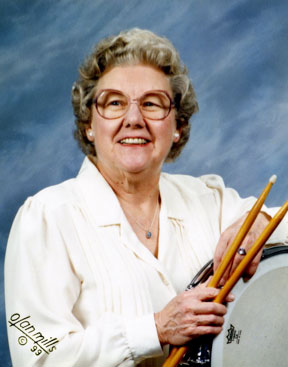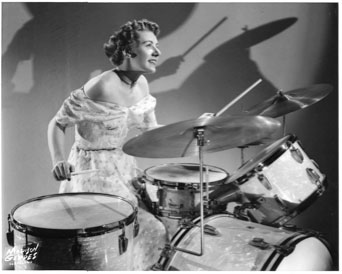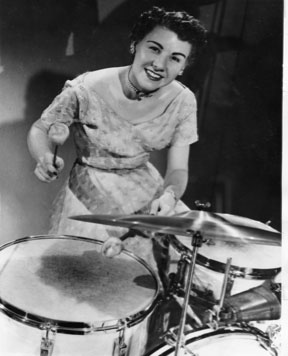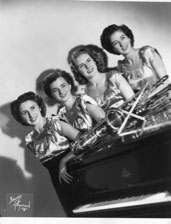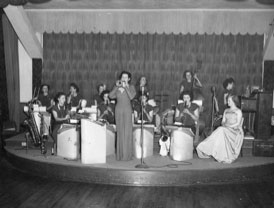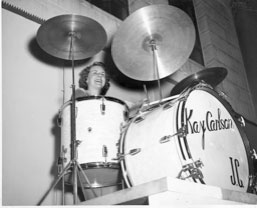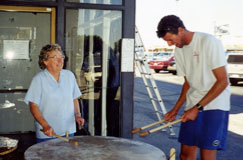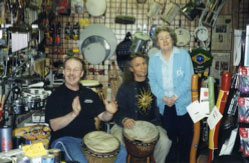 |

Noisy Toys interviews:
Kay Carlson - Veteran Drummer and
Percussion Instructor 1931 - 2010
|
|
Kay Carlson was an award-winning drummer who taught thousands of students in the Los Angeles area to play percussion and drum set for more than 50 years. She was a percussion instructor at Loyola Marymount University and had a private studio at Amendola Music for many years. She toured around the world in various bands and orchestras in the 1940s and 1950s. |
|
|
She won the EPPI Award from the REMO Drum Company for Excellence in the Profession of Percussion Instruction in 1989. She received a Certificate of Recognition from Pro Mark for Exceptional Dedication to Percussive Music Education. She was featured as a musical pioneer in the 2007 documentary “Lady Be Good - Instrumental Women In Jazz.” Kay participated in many Noisy Toys drum circles and events since Noisy Toys opened in 1996. She was teaching a select group of students within days of her death April 5, 2010.
This interview was conducted by Sharon Dale Talbot at Kay’s Los Angeles home in February 2010.
|
|
|
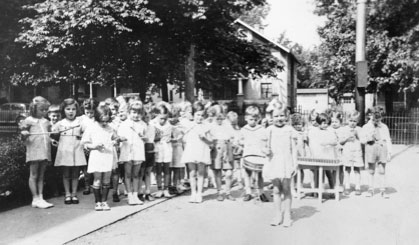
Kay leading her kindergarten class band in Cleveland, Ohio
|
|
NT - How old were you when you started taking drum lessons?
Kay - My parents were very poor and my grandparents lived with us, all in one apartment. There was a piano in the apartment and my sister decided that she wanted to take piano lessons because the girl up the street was taking piano lessons. So, as soon as I heard that I went to my parents and said if she’s going to take piano lessons, I want to take piano lessons. I was about 10 years old.
My mother and father said, “No way. We can’t afford lessons for the two of you. Only one of you. Your sister gets the lessons and you’ll have to bide your time.” After a short time passed and I was crying all the time, my mother told me she had a friend who used to be the percussionist for the theater in downtown Cleveland, Ohio. She was going to ask him if he could help. He offered to give me drum lessons for free. So, I tried out the drums and I loved it!
About two weeks after I started drumming my sister quit piano and never touched it again. So it was fate. I stayed with my first teacher and he gave me an old drum set that he used in the theater. You wouldn’t believe how old it was, but it was my pride and joy. I worked diligently on the drums. |
|
|
|
NT - How unusual was it in the 1940s for a girl to be studying drums?
Kay - Very unusual. In high school I became a member of the high school band. Because I was taking lessons and learning how to read music I was able to play better than most of the boys, so I became head of the drum section. The only girl. I was known as “The Girl Drummer.”
The boys played the drum set for the dances and I was very jealous because I didn’t learn the drum set right away. They were playing without any idea what they were playing. However, I was still satisfied with the marching band.
I continued with my drum lessons and started playing jobs around town as soon as I had a drum teacher who had some knowledge and would work with me on the drum set . I picked it up quickly. Then I started playing around town, getting jobs, while I was still in high school. I graduated from high school in 1949.
I joined a group that had a girl on trumpet and needed a drummer. By that time I was teaching drums to some of the boys in the high school band because they needed to catch up. I made them pay me 50 cents a lesson!
NT - What did your friends think of your drumming at the time?
Kay - It seemed to be quite normal at the high school until I started playing drums around the town. Then a lot of people noticed the woman in the band playing trumpet. That was unusual. But it was REALLY unusual to see a girl on the drum set. I got a lot of jobs, not because I was a girl, but because they needed a drummer and needed a drummer and I was schooled.
|
|
|
|
NT - After about 10 years of studying drums in Cleveland, Ohio you joined the Cleveland Women’s Symphony. Was it common to have a separate women’s symphony?
Kay - In Cleveland it was the norm. I learned through talking with some of the other musicians that the male symphony was strictly men, and the only woman was the harpist. So someone formed the Women’s Symphony and we played concerts. I joined the musicians union, which you had to join to be part of the symphony and be paid for it.
In 1949 I was supposed to go to college to study music. That was my plan. And I was debating between Ohio State and Michigan State. And then along came a surprise. My mother had a son, my brother, late in life. The family decided, because they still weren’t very wealthy, that he would be the one that they would send through college. My music was important, but his future was more important. I was disappointed, but my music turned into a lot of jobs and I met a lot of musicians. I played a lot of styles of music and traveled a lot locally.
NT - Starting in 1951 and all thru the 50’s you performed with touring orchestras, big bands and other groups. What did you wear to perform?
Kay - I had 3 or 4 gowns that I wore. Unfortunately they had long skirts and I chose incorrectly to wear dresses because that’s what the men expected. Until one day when I was sitting at the drum set and I was straddling the snare drum a woman came up during intermission and she said, “That is terrible! Do they have to make you wear a dress?” She was very upset and said, “We can see all the way up to your undies.”
(Laughter) I just hadn’t paid attention. So I immediately bought an evening-type pair of slacks and wore slacks or pants from then on. It was so embarrassing!
NT - Was it typically expected that you were required to wear a dress or a gown?
Kay - Yes. The women in the symphony all wore a dress or long skirts. They wore black skirts with a white blouse to look like the men. (Laughing)
Now that I think about it, it was pretty funny. On the road we had gowns and dresses.
NT - Wasn’t it hard to move and play drums dressed that way?
Kay - Yes, it’s very difficult. The most difficult part is wearing high heels on the foot pedal. I had to wear high heels for a while, until I figured out that I could secretly change to flat, evening type shoes, during the intermission. Then after a while I graduated to wearing flats all the time, but it was a gradual process. When I played in the western band on TV (the Spade Cooley Show) I had to wear western boots. They had a heel which was very uncomfortable, but I got accustomed to working the pedals. You do what you have to do.
|
|

The Spade Cooley Western Show 1957
|
|
NT - In 1956 you were the drummer with Johnny Grant’s show touring in Japan & Korea for the U.S. troops. What were the highlights of that experience?
Kay - Rita Moreno was on that tour with us. They had the Four Horsemen, which was a vocal group from the Jack Benny Show, and they were terrific. It was supposed to be an hour show, but it usually went over that. Rita Moreno was the star of the show and she wore very tight, low cut dresses for the boys in the service who we entertained. Every place that we played, Johnny Grant was the Emcee and also did a comedy routine.
I was part of an all girl band called the Joy Cayler Orchestra, and we toured all over South Korea, all the way up to the DMZ. We also took a tour of the DMZ line. At all of the performances there were outlying groups of Quonset huts where they had a battalion of soldiers, and we would go out there to entertain them. We would go in a bus on a bumpy and dusty or muddy dirt road, depending on the weather. Johnny Grant and Rita Moreno flew in by helicopter! (Laughter)
I had a drum solo I had to play at the end of each show and that was the most fun! But I really liked playing the back up for all those entertainers. who were so good. The singers, the dancers, Johnny Grant and his 10 gallon hat. It was really tall!
|
|
|
|
NT - Did you enjoy touring with the bands?
Kay - From Day One, when I joined my first traveling band, the Jo Scott Quartet, which was around 1950, fate took a hand in my joining that group. They were in Cleveland performing in a local restaurant on the east side of town. I begged my father to let me go see this all girl band because I had never seen a girl drummer before. It was exciting to me.
He finally said “yes.” So, we went from the snowy west side of Cleveland where we lived to the east side so I could watch another girl drummer. I was young and a little bit egotistical, and I said “I could do that!” (Laughter)
I wanted to tell the drummer in the group that she did a nice job and I wanted to tell the girls in the band how much I enjoyed them, before my father insisted on leaving. It was the last set and he felt it was late for Kay to be up. So, I went into the bathroom and there were the girls in the band, combing their hair and fixing their makeup. They were all there. I became very bashful.
Then, the girl drummer left the bathroom. Jo, the leader of the band said, “Oh good. That’s great. Can you go?” I said, “Go where?” (Laughter) She said, “Our drummer is leaving and we need a drummer. Are you interested?” I said, “You’ve never heard me play!” She replied, “That’s all right. Can you do what she did?” I said, “Yes, I think so.” She told me, “OK. You’re hired!” I said, “That’s great! But I have to check with my folks first.” I told the girls I was 19 and they said, “We won’t have any trouble with that because the places where we play serve food, not alcohol.”
I kept in touch with the band. They had two more weeks to perform and their drummer was given two weeks notice. The next thing I knew I was in Niagara Falls, on the road with the Jo Scott Quartet. This was heaven to me! I’d never been out of Cleveland before and this was a vacation! This was something so fantastic, like out of a dream! I’m going to play in an all girl band at Niagara Falls, where I’ve never been, and we’re going to play for a whole two weeks!
|
|
|
|
NT - How did the members of the Jo Scott Quartet know you were a drummer?
Kay - The band members had given the waitress a note to give me before the intermission, but the waitress never gave it to me. So I asked them, How did you know I was a drummer?” They said the waitress who failed to give me the note told them about me.
NT - How did you feel about the Johnny Grant Show tour?
Kay - It was an experience that was more like a dream. I felt like I was going to wake up every day and I would be in an office some place as a secretary trying to make a living. It was fantastic!
NT - Like a dream come true?
Kay - Definitely! Every time I went along in my career someone, like Joy Cayler, heard about me from some other drummer, musician or band and I would get the jobs on referrals.
|
|
|
|
NT - Who was Joy Cayler?
Kay - She’s a fantastic trumpet player. She was the featured soloist in her band. She was so fine! All the girls in Joy Cayler’s band were 10 years older than I. She had a band before the one I was in. She broke up that band and decided she wasn’t going to be on the road any more. But she got some offers she couldn’t turn down. She decided to get a young band because the older ladies didn’t want to travel any more.
|
|
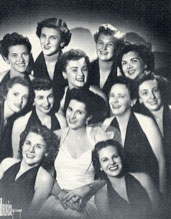
The Joy Cayler Orchestra
|
|
NT - Were you ever worried about your safety during the USO tours overseas?
Kay - No. It was right after the war and every place we went we were the stars. I remember vividly they drove all the girl musicians to one of the camps in a bus, along with some of the guys who were in the show and didn’t get to ride in the helicopter. I would get off the bus and take pictures with my 8 mm movie camera. I was taking pictures of all the GI’s who were taking pictures of me! There was always a group of guys who were anxious to meet us and get our autographs. I thought, “This is glorious! This is a dream!”
NT - What’s the story behind your first professional glossy photograph?
|
|
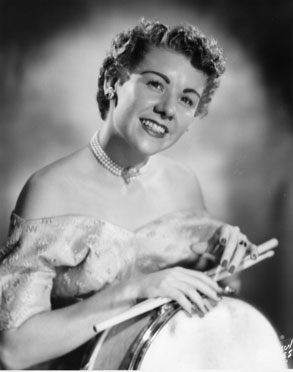 |
Kay - I had to have a picture for going on the road with the different bands. They wanted an 8 by 10 glossy. I went to a photographer in Cleveland and he arranged the set up for me with my first drum set. I was wearing a dress, but it didn’t look the same as it does in the picture. The gown was originally made to be up to here, not off the shoulder. I was posed and ready when he came out from behind the camera and said, “No, no. That just won’t do.” I said, “What’s wrong?” He said, “I have to fix something.” Then he pulled down the gown off both my shoulders and said, “Now we’ll take the picture!” (Laughter)
|
|
|
NT - There’s a photo of you in the Joy Cayler band with your name in big letters on your bass drum. What’s the story there?
Kay - I don’t know what I was going through when I was 19 or 20. But looking back, I must have had some kind of strange ego. (Laughter) It wasn’t necessarily acceptable. I went out and got a special painter who only wrote on drum heads. It cost me quite a penny! The initials of Joy Cayler’s band are at the bottom of the head and mine are at the top. This was not the way it was done! The band name, like “Benny Goodman,” would be in big letters at the top and the drummer’s initials were in small letters at the bottom. Joy came to me and was furious. She demanded that I change it. This made it look like it was my band!
NT - Did you have to change it?
Kay - Sure I changed it. But I got a picture of it first! (Laughter)
|
|
|
|
NT - Who was your first professional sponsor?
Kay - A man from Ludwig Drums wanted to sponsor me because there weren’t very many girl drummers in his sponsorship. He took one of my glossy pictures. This was at the same time I spent time in Chicago studying with Bob Tilles, one of my teachers. Bill Ludwig came to see the band and put the picture in Downbeat magazine in 1952. That was only a few years after I graduated from high school.
|
|
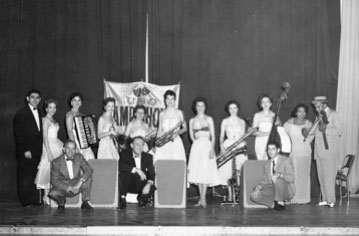
USO Tour of Greenland, Labrador & Newfoundland with the Pat Sheridan Jazz Quintet
|
|
NT - Some time in the late 1950s you moved to Los Angeles and in 1960 you organized your own 19 piece band. Tell us about your group.
Kay - I was trying to break in to doing some studio work. It was a closed shop. They only had male musicians working in the studios. The only women were harpists. So I was trying to figure out how I could get into studio work. I didn’t realize how far beyond me that was because you had to know so much more than I knew then. (Laughter)
I thought there must be a way I can at least work with some of the studio musicians and get the experience. Then maybe eventually I could work in the studio. A devious plan! So I asked a friend who was an arranger about putting together a rehearsal band. It was called a “kicks’ band. Kicks for fun. We would get together and sight read a bunch of charts. That was like tasting a bunch of different food. It was fun to do!
I had to organize it, so I had to call musicians who called other musicians and so on. We had 19 pieces and rented a rehearsal hall. We had special music my friend arranged. It was a selfish way of playing along with studio musicians. It was a great experience! It was all great players. I did that for about 10 years.
|
|
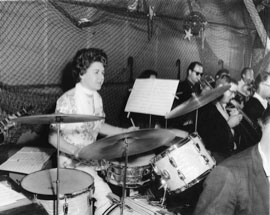
Kay performs at a party in 1963
|
|
NT - Did you ever get to work in the studio?
Kay - No. But we played some jobs. Most of them were concerts at the beach in Venice. They used to have an outdoor theater in Venice. It was called “Music at the Beach.”
|
|

Venice Beach Hotel 1963
|
|
NT - How did you start teaching at L.A. area schools in the 1960s?
Kay - When I started teaching it was with a friend who was a trumpet player. We went into some private Catholic schools where we were trying to help young people learn music at an early age. We got paid for it, but the real purpose was to get students involved in music.
NT - The 60’s was a transformative time for music. Rock and Roll was becoming popular. What are your favorite music styles to play?
Kay - My object was to play a little bit of everything. I started out enjoying jazz and I still enjoy jazz the most. Rock and roll has gone through so many different styles that you have to keep on learning to keep up. I didn’t get a lot of jobs in rock and roll because it was mostly groups organized with guitars and drums. The music I enjoy the most included horns. Lots of horns!
|
|
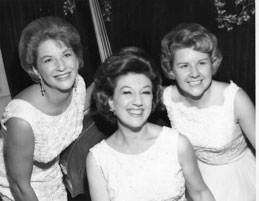
Joyce Wellington Trio performs at Ambassador Hotel, Los Angeles 1964
|
|
NT - You opened your own studio at Amendola Music in 1973 and worked there many years.
Kay - Before that I was making house calls, because that was where the money was. I taught percussion at Westchester Music starting around 1960. Then I joined Amendola Music and opened a studio there.
|
|
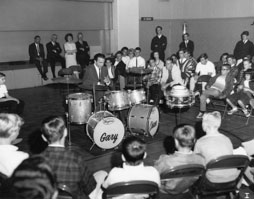
Drumming legend Louie Bellson performs for Kay’s students at Westchester Music
|
|
NT - How many drum students have you had over the years in the Westchester area?
Kay - At last count there were two-thousand. (Showing me two large boxes full of file cards with the names of her students.)
NT - I’m sure you don’t remember all of them, but they remember you! Do some of them still keep in touch with you?
Kay - Yes. I have a part time secretary now to help me keep in touch. We sent out about 60 e-mails to try to keep up with the e-mail addresses of former students that I have. We got a lot of responses. (Showing me a page full of testimonials from former students.)
NT - A lot of former students attended your party in 2006, celebrating your 50 years of teaching percussion. It was a fun party!
Kay - Considering that I started teaching when I was in high school, it may have been even longer than 50 years!
|
|

Noisy Toys co-owners Sharon and Bill Talbot at Kay’s party in 2006
|
|
NT - What advise do you give your drum students starting out today?
Kay - Learn how to read music! It stands to reason, if you think about it. We write e-mails every day with complete control of the English language. Music notes are the language of music. So you should learn how to read music, so you can learn how to write music. It’s all the same things you do with the English language. If you think of it that way, the reason for learning how to read music becomes very important.
Consider that a symphony orchestra can be made up of musicians from many different countries. If you were to have arrangements for them there would be words, possibly, in their language that tells them how fast or slow or how loud or soft to play. It also tells how to interpret some of the songs. They would have the information in that language, but the written notes would be legible for everyone in the orchestra. Everyone could play the music together and it would sound beautiful
NT - You’re still teaching children how to make beautiful music. Thank you for contributing so much to them and to the community! And, thanks so much for sharing your story.
(Kay passed away peacefully after a sudden illness on April 5, 2010.)
|
|
|
|
Kay at Noisy Toys Drums & Percussion in 1998 and 2000
|
|
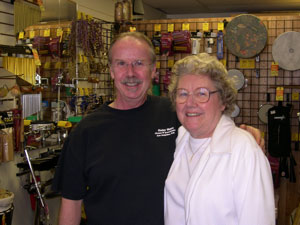
Bill Talbot and Kay at Noisy Toys in 2005
|
 |

[ home ] |
| <- interview index - |

